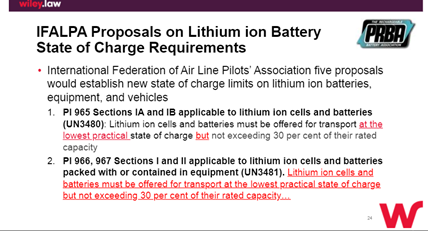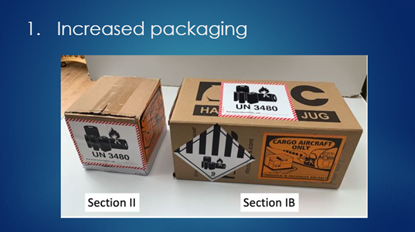
To the surprise of absolutely no one, lithium batteries became a primary focus of the 2021 Dangerous Goods Symposium as it moved into its second week. Two key sessions focused exclusively on battery-related regulations and issues, and the topic came up in others as well.
Here are the recordings of those two sessions, which you can stream at no cost on-demand:
Live with the Lithium Battery Panel featured an all-star panel of experts from the regulatory world, aircraft manufacturing, airlines and training.
Are My Lithium Batteries Safe to Transport? with a panel of Labelmaster experts getting into the granular details of transporting damaged, defective or recalled lithium batteries.
(If you haven’t already, you’ll have to set up a free account at the DG Exchange to stream these and other sessions.) And here are the 8 most important things we learned about compliant lithium battery transport during this year’s Symposium—so far.
#1: Lithium batteries in transport could soon double or triple.
With the pending U.S. Senate Infrastructure bill including $6.1 billion to support battery manufacturing, recycling, electric vehicle manufacturing and charging infrastructure, George Kerchner, Executive Director of PRBA–The Rechargeable Battery Association, foresees this enormous growth in transport of larger, fully regulated lithium batteries.
Of course, lithium battery growth in general has been the prevailing trend for a decade or more. Organizations in the Dangerous Goods supply chain—don’t say you haven’t been warned!
#2: The industry is collecting better data on lithium battery incidents.
Dangerous Goods rulemaking should ideally be data-based, but according to Robert McClelland of UPS—who’s also a member of the DOT’s Lithium Battery Air Safety Advisory Committee, “The data was fragmented, very generalized, and there wasn’t a lot of actionable information.”
That’s why a group of airlines in collaboration with Underwriters Laboratories established TRIP—the Thermal Runaway Incident Program.

TRIP has tracked 365 incidents since 2017—on both passenger and cargo aircraft—to hone on in on what kinds of batteries or devices were involved, what may have happened before incidents, and other data that can help rulemakers understand holes in the regulations and how to fix them.
#3: The G27 Committee is making progress. Really!
Speaking of rulemakers … the SAE G-27 Lithium Battery Packaging Performance Committee, tasked with establishing standards for lithium battery packaging that’s safe for air transport, is “seeing the light at the end of the tunnel,” according to Kerchner. “It’s been five or six years, but it feels like 20. We’ve made a lot of progress over the last year or so and hope to finish in the next year.”
#4: Shipping damaged, defective and recalled lithium batteries can hurt your brain.
If the rules for shipping lithium batteries compliantly are complex, they get even more mind-boggling when the batteries are damaged, defective or recalled (DDR). Labelmaster Senior Consultant Alicia Saenz points out that batteries can be so badly damaged they doesn’t even qualify as batteries anymore, but many shippers will ship them as if they are fully regulated, anyway, just to be safe.
She shared this chart, which describes some of the most common forms of battery or device damage to help shippers classify them for transport.

The items in green are often shipped as normal lithium battery shipments, purple items are a judgment call, and red items are typically shipped as damaged or defective.
#5: Shipping DDR lithium batteries? Special permits make your life a lot easier.
You cannot compliantly transport damaged, defective or recalled lithium batteries in fiberboard packaging, and your teams will need training for fully regulated shipping—unless you have a special permit.
“There’s a lot of great special permit packaging out there,” said Labelmaster Global Development Manager Thaddeus Puccini, “but you need to read the special permits to know what special permit is for what package. Not all special permits are the same or read the same—there’s no boilerplate special permit.”
#6: About those packaging special permits … look closely at the testing.
To obtain a special permit, packaging manufacturers have to supply data and video of the packaging being tested. PHMSA and other authorities don’t test the packages themselves—they rely on manufacturers’ tests to grant special permits.
Puccini says, “When you’re getting special permit packaging—and I cannot stress this enough—ask to see the video. Ask to see the data. Don’t accept a piece of paper. Ask questions, like ‘What was tested, and what was the state of charge of what was tested?’”
You want special permit packaging tested against the batteries and devices most similar to the ones you’ll be shipping. That’s why you need to know as much detail as possible about the testing behind your special permit.
#7: There’s more controversy about lithium-ion batteries’ state of charge.
A few years back, ICAO imposed a 30% state-of-charge limit for lithium-ion batteries shipped by air. Now, a new proposal would change the language of the applicable regulations to require they be offered “at the lowest practical state of charge but not exceeding 30 percent of their rated capacity.”

“I have no idea what that means,” said Kerchner. “That vague term could have various interpretations. We really don’t think that language should be in any type of regulation because of the uncertainty as to what it means.”
Asked about this proposal in a later session, Duane Pfund, Program Coordinator of PHMSA’s Office of Hazardous Materials Safety, replied, “There’s a safety objective here—the lower the state of charge, the less reaction. But it’s extremely difficult from a regulatory perspective to incorporate that kind of text. I can’t answer as to how we’d be able to enforce that. We’d have to sort that out.”
#8: Even the experts disagree on lithium battery transport regulations.
As related by IATA Assistant Director of Cargo Safety & Standards Dave Brennan, air carriers were concerned about a conflict that arose because “they have to perform a safety risk assessment and understand what is going to be put in the cargo compartment, and yet we’ve got Section II packages which are designed to move through the transport stream without the operator doing an inspection check.
“The view of the IATA Dangerous Goods Board was that these two conditions are incompatible. It was proposed to delete Section II, and that was adopted.”
Geoff Leach, Director of The Dangerous Goods Office Ltd. and a member of the ICAO Dangerous Goods Advisory Council, feared that this well-intended action might have unintended consequences. He pointed out that Section II had helped shippers save on packaging, training and handling costs.

“My concern,” he said, “is does this increase the risk of undeclared Dangerous Goods? Could certain shipments be driven underground?”
Conversations like these are why the lithium battery panel is a highlight of every Dangerous Goods Symposium.
Stream the entire DG Symposium on demand
If you missed these sessions, no worries—if you’re a DG Exchange member, you can go back and stream them on demand, at no charge.
Convince and Convert: What Makes Attention Getting Content for Your Audience, with marketing consultant Laura Denk.
IMDG Code Amendment 40-20 Update, with veteran Dangerous Goods consultant and trainer Richard Masters.
International Regulatory Updates: UN and ADR, with PHMSA’s Duane Pfund and Kristel Vermeersch, founder of KVS & Partners.
International Regulatory Updates: IATA & South America, with IATA’s Dave Brennan and CIQUIME Director Diego Gotelli.
Partners in Dangerous Goods – The FBI, with FBI chemist Dr. Charles Luman.
Cybersecurity and Infrastructure & Chemical Facility Anti-Terrorism, with Mitch Paine and Sam Duchac, of the U.S. DHS Cybersecurity and Infrastructure Security Agency.
A Snapshot of Container Shipping 2021: The Suez Canal and Other Water Related Issues, with veteran Dangerous Goods consultant Richard Masters.
Optimized and Compliant: Let’s Review Your Shipping SOPs, with Pierbridge Senior Channel Manager Bob Liva and Labelmaster Software Director of Strategy, Kristen Dapore.
Understanding the Future of Freight Transportation, with FTR Chairman and CEO Eric Starks.
And there are still two more sessions tomorrow:
FAA Updates, September 24, 10:00 AM CT, with FAA Executive Director Ben Supko.
Dangerous Goods and the eCommerce Effect, September 24, 2:00 PM CT, with Dangerous Goods consultant Cathy Roberson.
Mark your calendar for the 2022 Dangerous Goods Symposium, Sept. 9-11, in person and back in Chicago! Make sure your shipments are safe and in complete compliance with a full line of solutions from Labelmaster—a full-service provider of goods and services for hazardous materials and Dangerous Goods professionals, shippers, transport operators and EH&S providers.



Attended/watched 3 sessions (first year). Disappointed in the time allowed for Q&A. Hoping for more time and conversation in 2022.
John, thanks for your honest feedback. We will be following up with you on how to get your questions answered.
The Labelmaster Team